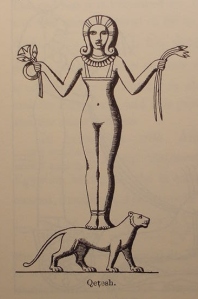“It was not in the power of woman, no–nor in the power of himself–to have made John Mytton a good husband; indeed, he ought not to have entered into the marriage state at all.” — Memoirs of the Life of the Late John Mytton, by Nimrod
The real Regency rake poses a problem not only to himself but to the woman who thinks to conquer him.
Regency scholars were amazed at the reports brought back to them of Egyptian antiquities, particularly fascinated with the way women were depicted in mythology. Hathor, queen of heaven and perhaps a bastardization of the imported cult of Aphrodite/Diana, was discovered on many a priestess tombstone standing upon a lion. Gentlemen who studied the classics surmised that this motif was love was conquering the beast.
Whether such a miracle can be wrought (on a permanent basis) has yet to be proved.
John Mytton had been married before–to Harriet Emma–but she died in 1820 after two years of marriage.
Nimrod (Charles James Apperly) remembers counselling the mother of Mytton’s second wife. Her daughter Caroline was the issue of the late Earl Courtney of Powderham Castle in Devon. When her daughter was seventeen years of age, she approached Mytton’s close friend for advice and received this ambivalent response:
“In my opinion, Lady Charlotte, Mr. Mytton has no business with a wife at all; but should he marry your daughter, Caroline, there is a greater prospect of his making a good husband to her, than to any other woman in the world.”
Isn’t that always the case? You alone have the best chance, but beware–the man has no business with a wife at all.
Caroline bore Mytton five children after marrying him in 1821. She saw him throw their babies up in the air and pelt them with oranges. That was more than enough. She ran away from him in 1830.



Aack! Rake and child abuser. I’m glad she ran away.
LikeLike
I wonder what was the straw that finally broke the camel’s back?
LikeLike
I agree with Ally. Who would want to be married to a rake anyway?
Interesting post. I guess rakes aren’t that romantic after all.
LikeLike
Mytton certainly wasn’t very romantic. He was too busy being beastly.
LikeLike
“She saw him throw their babies up in the air and pelt them with oranges.” Rather horrifying and… really odd.
LikeLike
He was odd. His friends (amazing he had any) were endlessly speculating whether he was indeed mad.
LikeLike
I think they can be reformed. My husband was a rake, and has been wonderful husband and father. I’m so glad she had the fortitude to leave him.
LikeLike
Reformed rakes are a rarity, I suspect. No surprise you have one for a husband, Ella–your writing is very romantic!
LikeLike
I don’t think there are very common, but there’s a real life example who turned into a good husband and had a long and loving relationship with his wife. Granville Leveson-Gower married Harryo Cavendish (daughter of Georgiana, Duchess of Devonshire) even though she didn’t want much to do with him originally after she found out he’d been her aunt’s lover for years and they had two illegitimate kids together. And yet, their letters and those of family and friends show they were very much in love for years until his death. It’s nice to know that all our reformed Regency rakes have at least 1 real life progenitor. 🙂
LikeLiked by 1 person
I shake my head. I assume she couldn’t take the children?
LikeLike
I have reason to think she did–Nimrod speaks of Mytton living “in exile” that is, away from his creditors, and expressing how much he missed his children. When he died, his oldest son was fourteen and at Eton, the entire estate that was entailed going to him. His first wife’s fortune was settled upon his daughter by that marriage. The remaining children received nothing from him, he being a pauper upon his death.
LikeLike
Very sad for the children to lose their father so early. Nice to know he missed his children. Maybe the pommeling with oranges was done in fun?
LikeLike
Her mother should have listened to the warning. “…Mr. Mytton has no business with a wife at all.” is pretty straight-forward.
LikeLike
Yes, Mytton’s friends had intimate knowledge of his suitability as a husband.
LikeLike
I’m still pondering the choice of ‘Nimrod’ for a nom de plume…
LikeLike
And well you should. Today it has a negative connotation–meaning silly or stupid fool. But in Mytton’s time, it meant mighty hunter. The two ideas were united in the surprising figure of Elmer Fudd.
LikeLiked by 1 person
that is definitely the kind of info I’ll try to work into conversation at parties!
How cool!
LikeLike
Pingback: Love and the Real Regency Rake | Angelyn's Blog